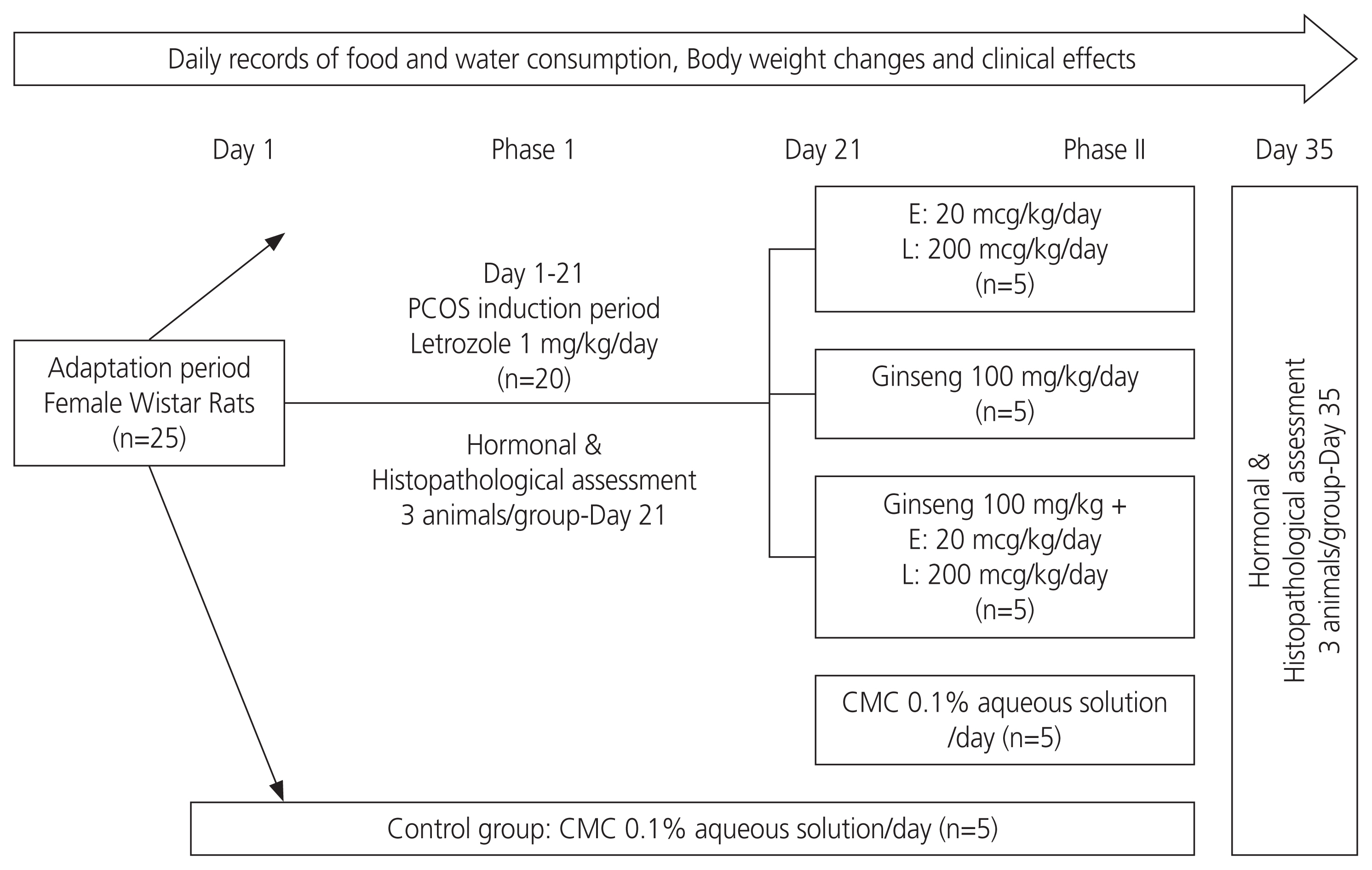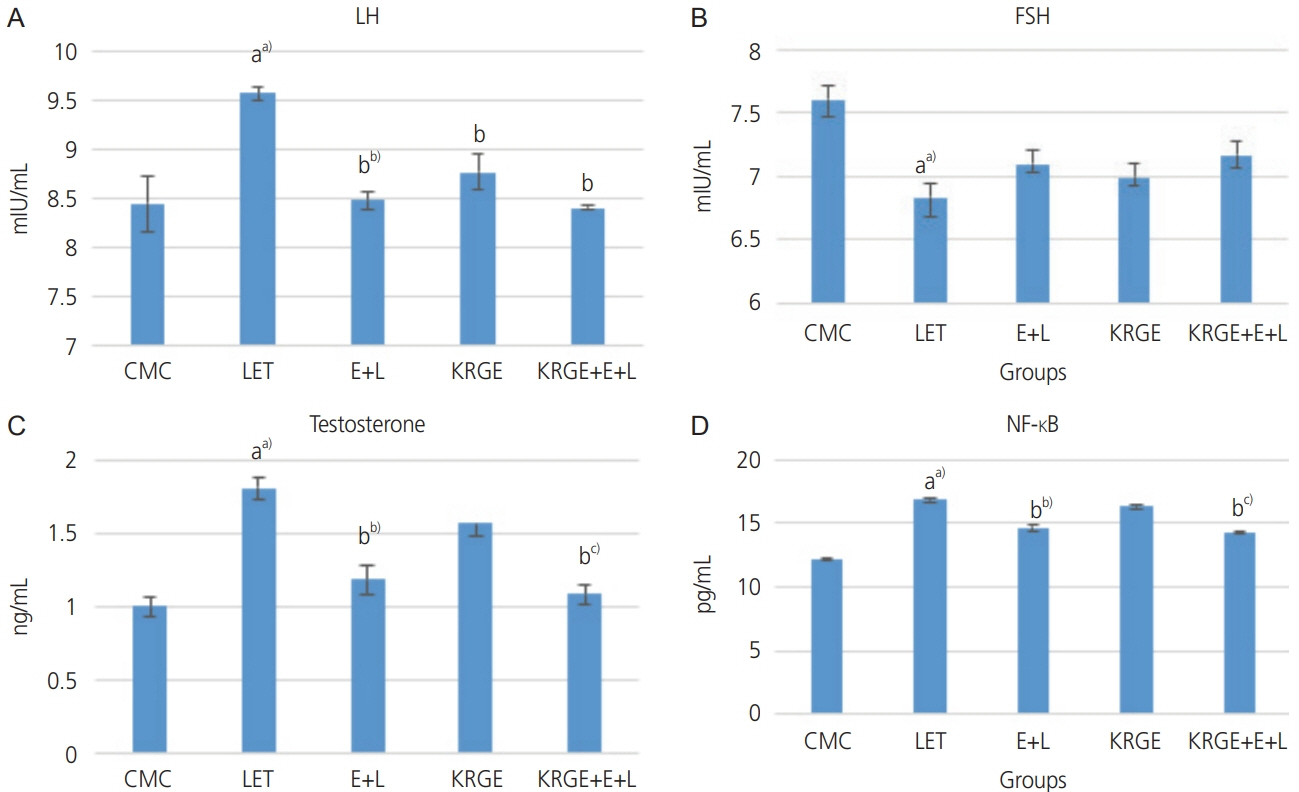Obstet Gynecol Sci.
2021 May;64(3):274-283. 10.5468/ogs.20094.
Ovarian cysts disappear after 14-day oral regimen of Korean red ginseng extract in letrozole-induced polycystic ovarian syndrome
- Affiliations
-
- 1Faculty of Pharmacy and Pharmaceutical Sciences, Islamic Azad University, Tehran Medical Sciences University, Tehran, Iran
- 2Department of Toxicology and Pharmacology, Faculty of Pharmacy and Pharmaceutical Sciences, Islamic Azad University, Tehran Medical Sciences University, Tehran, Iran
- 3Department of Gynecology and Obstetrics, Faculty of Medicine, Islamic Azad University, Tehran Medical Sciences University, Tehran, Iran
- KMID: 2515979
- DOI: http://doi.org/10.5468/ogs.20094
Abstract
Objective
Hormonal and inflammatory mechanisms are involved in the pathogenesis of polycystic ovarian syndrome (PCOS), which is a prevalent metabolic disorder among women of reproductive age. We aimed to evaluate the comparative efficiency of short-term oral administration of Korean red ginseng extract (KRGE) and the standard treatment on PCOS by focusing on the histopathological parameters and serum levels of luteinizing hormone (LH), folliclestimulating hormone (FSH), testosterone, and nuclear factor kappa B (NF-κB).
Methods
A PCOS rat model was established by oral gavage of letrozole (1 mg/kg) for 21 days. The serum levels of LH, FSH, testosterone, and NF-κB were measured, and the morphological features and differences of the ovaries were examined in each group using a light microscope before and after 14 days of treatment with oral regimens—KRGE, oral contraceptives (OCPs), KRGE+OCPs, and carboxymethyl cellulose (CMC).
Results
OCPs alone could not normalize the mean ovarian weights of PCOS rats despite the 14-day oral regimen, but they were more effective in reducing the number and size of cysts compared to others. KRGE alone and in combination with OCPs was effective in normalizing abnormal ovarian weights, decreasing LH serum levels, and dissipating the ovarian cysts in PCOS rats. However, when combined with the standard regimen, KRGE showed additional therapeutic effects by efficiently reducing serum testosterone and NF-κB levels.
Conclusion
Our necropsy and histopathological evidence suggests the efficacy of KRGE as a novel integrative medicine against abnormal multiple follicular cysts. However, antiandrogenic and anti-inflammatory effects were only seen in animals that were administered a combination of KRGE and the standard regimen.
Figure
Reference
-
References
1. Walters KA, Gilchrist RB, Ledger WL, Teede HJ, Handelsman DJ, Campbell RE. New perspectives on the pathogenesis of PCOS: neuroendocrine origins. Trends Endocrinol Metab. 2018; 29:841–52.
Article2. Yildiz BO. Oral contraceptives in polycystic ovary syndrome: risk-benefit assessment. Semin Reprod Med. 2008; 2:111–20.
Article3. Victor VM, Rocha M, Bañuls C, Sanchez-Serrano M, Sola E, Gomez M, et al. Mitochondrial complex I impairment in leukocytes from polycystic ovary syndrome patients with insulin resistance. J Clin Endocrinol Metab. 2009; 94:3505–12.
Article4. Teede HJ, Misso ML, Deeks AA, Moran LJ, Stuckey BG, Wong JL, et al. Assessment and management of polycystic ovary syndrome: summary of an evidence-based guideline. Med J Aust. 2011; 195:S65–112.
Article5. Damone AL, Joham AE, Loxton D, Earnest A, Teede HJ, Moran LJ. Depression, anxiety and perceived stress in women with and without PCOS: a community-based study. Psychol Med. 2019; 49:1510–20.
Article6. Behboodi Moghadam Z, Fereidooni B, Saffari M, Montazeri A. Measures of health-related quality of life in PCOS women: a systematic review. Int J Womens Health. 2018; 10:397–408.
Article7. Palioura E, Diamanti-Kandarakis E. Polycystic ovary syndrome (PCOS) and endocrine disrupting chemicals (EDCs). Rev Endocr Metab Disord. 2015; 16:365–71.
Article8. Zuo T, Zhu M, Xu W, Wang Z, Song H. Iridoids with genipin stem nucleus inhibit lipopolysaccharide-induced inflammation and oxidative stress by blocking the NF-κB pathway in polycystic ovary syndrome. Cell Physiol Biochem. 2017; 43:1855–65.
Article9. Escobar-Morreale HF, Luque-Ramírez M, González F. Circulating inflammatory markers in polycystic ovary syndrome: a systematic review and metaanalysis. Fertil Steril. 2011; 95:1048–58.e1.
Article10. Liu M, Gao J, Zhang Y, Li P, Wang H, Ren X, et al. Serum levels of TSP-1, NF-κB and TGF-β1 in polycystic ovarian syndrome (PCOS) patients in northern China suggest PCOS is associated with chronic inflammation. Clin Endocrinol (Oxf). 2015; 83:913–22.
Article11. Nehir Aytan A, Bastu E, Demiral I, Bulut H, Dogan M, Buyru F. Relationship between hyperandrogenism, obesity, inflammation and polycystic ovary syndrome. Gynecol Endocrinol. 2016; 32:709–13.
Article12. Sirmans SM, Weidman-Evans E, Everton V, Thompson D. Polycystic ovary syndrome and chronic inflammation: pharmacotherapeutic implications. Ann Pharmacother. 2012; 46:403–18.
Article13. Zaafan MA, Abdelhamid AM, Ibrahim SM. The protective effect of Korean red ginseng against rotenone-induced Parkinson’s disease in rat model: modulation of nuclear factor-κβ and caspase-3. Curr Pharm Biotechnol. 2019; 20:588–94.
Article14. Kim SJ, Kwak HJ, Kim DS, Choi HM, Sim JE, Kim SH, et al. Protective mechanism of Korean red ginseng in cisplatin-induced ototoxicity through attenuation of nuclear factor-κB and caspase-1 activation. Mol Med Rep. 2015; 12:315–22.
Article15. Choi JH, Jang M, Nah SY, Oh S, Cho IH. Multitarget effects of Korean Red Ginseng in animal model of Parkinson’s disease: antiapoptosis, antioxidant, antiinflammation, and maintenance of blood-brain barrier integrity. J Ginseng Res. 2018; 42:379–88.
Article16. Shim MK, Lee YJ. Estrogen receptor is activated by Korean red ginseng in vitro but not in vivo. J Ginseng Res. 2012; 36:169–75.
Article17. Najaf Najafi M, Ghazanfarpour M. Effect of phytoestrogens on sexual function in menopausal women: a systematic review and meta-analysis. Climacteric. 2018; 21:437–45.
Article18. Korea Ginseng Corp. Korean red ginseng extract, ginseng root, tea, capsule [Internet]. Seou (KR): Ginseng Corp.;c2020. [cited 2019 Oct 31]. Available from: https://www.kgcus.com/ .19. Jung JH, Park HT, Kim T, Jeong MJ, Lim SC, Nah SY, et al. Therapeutic effect of Korean red ginseng extract on infertility caused by polycystic ovaries. J Ginseng Res. 2011; 35:250–5.
Article20. Kafali H, Iriadam M, Ozardali I, Demir N. Letrozole-induced polycystic ovaries in the rat: a new model for cystic ovarian disease. Arch Med Res. 2004; 35:103–8.
Article21. Fernández-Martínez E, Pérez-Soto E, González-Hernández C, Ortiz MI, Pérez-Álvarez V, Muriel P, et al. Immunomodulatory effects by oral contraceptives in normal and cholestatic female rats: role of cytokines. Int Immunopharmacol. 2014; 21:10–9.
Article22. Mahsa S, Naeimeh D, Hamed DP, Hossein K, Nazanin SJ. Comparison of ginseng extract and metformin on improvement of polycystic ovary syndrome (POS). J Entomol Zool Stud. 2015; 3:501–5.23. Baravalle C, Salvetti NR, Mira GA, Pezzone N, Ortega HH. Microscopic characterization of follicular structures in letrozole-induced polycystic ovarian syndrome in the rat. Arch Med Res. 2006; 37:830–9.
Article24. Chung HS, Hwang I, Oh KJ, Lee MN, Park K. The effect of Korean red ginseng on sexual function in premenopausal women: placebo-controlled, double-blind, cross-over clinical trial. Evid Based Complement Alternat Med. 2015; 2015:913158.
Article25. Oh KJ, Chae MJ, Lee HS, Hong HD, Park K. Effects of Korean red ginseng on sexual arousal in menopausal women: placebo-controlled, double-blind crossover clinical study. J Sex Med. 2010; 7:1469–77.
Article26. Sun YF, Zhang X, Wang XY, Jia W. Effect of long-term intake of ginseng extracts on gut microbiota in rats. Zhongguo Zhongyao Zazhi. 2018; 43:3927–32.27. González F, Rote NS, Minium J, Kirwan JP. Increased activation of nuclear factor kappaB triggers inflammation and insulin resistance in polycystic ovary syndrome. J Clin Endocrinol Metab. 2006; 91:1508–12.28. Koc O, Ozdemirici S, Acet M, Soyturk U, Aydin S. Nuclear factor-κB expression in the endometrium of normal and overweight women with polycystic ovary syndrome. J Obstet Gynaecol. 2017; 37:924–30.
Article29. Xu Y, Ding J, Ma XP, Ma YH, Liu ZQ, Lin N. Treatment with Panax ginseng antagonizes the estrogen decline in ovariectomized mice. Int J Mol Sci. 2014; 15:7827–40.
Article
- Full Text Links
- Actions
-
Cited
- CITED
-
- Close
- Share
- Similar articles
-
- Beneficial effects of Teucrium polium hydroalcoholic extract on letrozole-induced polycystic ovary syndrome in rat model
- Regulation of estrous cycle by Cynodon dactylon in letrozole induced polycystic ovarian syndrome in Wistars albino rats
- Histologic comparison of polycystic ovary syndrome induced by estradiol valerate and letrozole
- Influence of combined oral contraceptives on polycystic ovarian morphology-related parameters in Korean women with polycystic ovary syndrome
- Preterm Ovarian Hyperstimulation Syndrome




